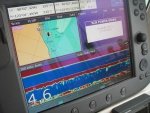We were on our way home yesterday from Shallow Bay, Sucia after a week and a half in the Gulf Islands. As we were southeast of Matia we hear a "MAYDAY, MAYDAY...40 foot wooden trawler hit a submerged rock, mouth of Ewing Cove! Listing 40*. Wife and dog in the dinghy!!"
Coast Guard chimes up as do several boaters much closer than us. Captain of the aground vessel says he hit an "uncharted rock". Since the lat/long numbers he provided were close to us, my wife looks up Ewing Cove, while I drive.
From the Waggoner's: "We have reports of a rock in Ewing Cove's southern entrance, from Echo Bay. The rock is east of a white can that marks a fish haven, shown on large scale chart 18431. We are told the rock is black and hard to see, and feeds on propellers at low tide. Be extra cautious..."
Low tide yesterday for Echo Bay: 0840 hours, -0.61'. This happened around 0915. As we rounded the northern tip of Lummi Island the CG fast-boat was smoking in that direction. Sounds like no one was injured, but I have no other info on the outcome. Boat named Halcion. Captain said at the time he did not know if the boat was taking on water or not.
Coast Guard chimes up as do several boaters much closer than us. Captain of the aground vessel says he hit an "uncharted rock". Since the lat/long numbers he provided were close to us, my wife looks up Ewing Cove, while I drive.
From the Waggoner's: "We have reports of a rock in Ewing Cove's southern entrance, from Echo Bay. The rock is east of a white can that marks a fish haven, shown on large scale chart 18431. We are told the rock is black and hard to see, and feeds on propellers at low tide. Be extra cautious..."
Low tide yesterday for Echo Bay: 0840 hours, -0.61'. This happened around 0915. As we rounded the northern tip of Lummi Island the CG fast-boat was smoking in that direction. Sounds like no one was injured, but I have no other info on the outcome. Boat named Halcion. Captain said at the time he did not know if the boat was taking on water or not.

